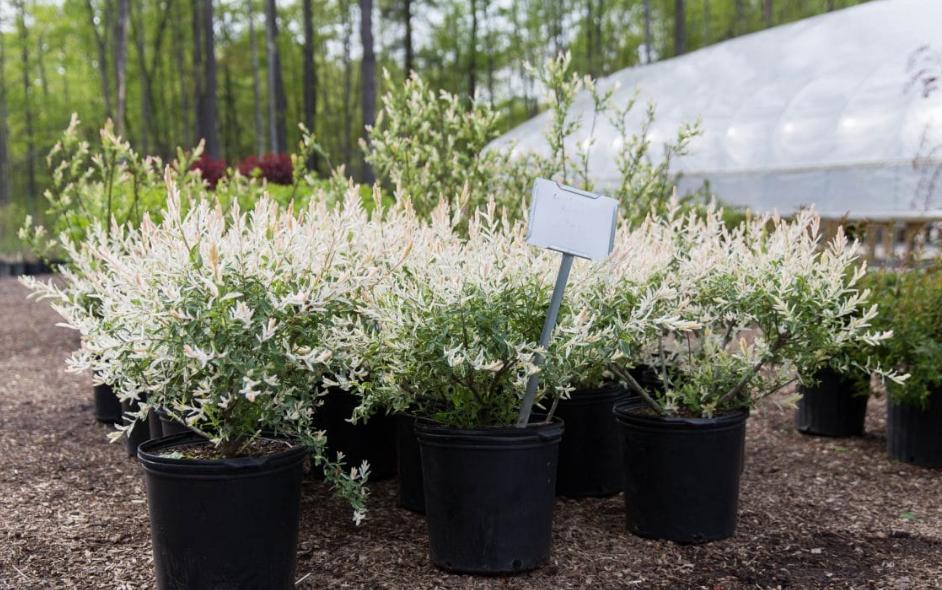Want to add a touch of discreet style to your landscape? The Dappled Willow, or Salix integra ‘Hakuro-nishiki’, is an appealing favorite of gardeners and landscapers alike because of its beautiful foliage and multi season interest. Featuring a rare blend of pink, white, and green leaves, this adaptable bush brings ordinary spaces to life with stunning variegated colors that everyone will pass by and notice from spring all the way into late fall.
Thank you for reading this post, don't forget to subscribe!In this guide, we’ll discuss the beauty and ease of care of Dappled Willow, as well as how to use this plant in your landscaping designs. Whether you’re a seasoned pro or a growing novice, you’ll find all the information you need to successfully plant, care for, and utilize this amazing shrub.
Features of Dappled Willow
Why is Dappled Willow a “standout” in gardens? 1) It’s all in what makes clutter, clutter.
Size and Growth Habit
Dappled Willow is a steady grower and grows rather fast for some reaching heights of up to 4-6 feet with a spread of 4-5 feet. Left unpruned, it may exceed 20 feet; however, the bush usually keeps a pleasing, naturally rounded form. This makes it ideal for small and large gardens.
Colorful Foliage
Spring: Leaves open with a blush of soft pink, fading to white and light green. One of the most noticeable features of this blush is the blushing effect.
Summer: The pink fades away and you’re left with a dappled combination of creamy white and green variegation that is just beautiful.
Fall: They turn yellowish-green before dropping, revealing the shrub’s red-tinted stems in winter.
This seasonal metamorphosis guarantees year-round interest, even in the barren months when other plants take the back seat.
How to Plant Dappled Willow trees
Starting your Dappled Willow off on the right foot starts with planting it in the right place.
When to Plant
Dappled Willow is best planted in the early spring or in the fall when the air is cooler. This will give the shrub a good amount of time to develop a root system before the heat of summer.
Location and Sunlight Needs
Location: Plant in full sun to part shade for best growth. Dappled Willow will do its best in full sun (6+ hours daily), but a part-shade spot will help retain its pink colors longer in the heat of summer.
Soil Requirements
This shrub is not super picky about soil, but it thrives in a moist, well-drained soil composition with a slightly acidic to neutral pH. The soil at least should hold water for longer, if not better! Dappled Willow adores wet areas and also does well near ponds or streams.
Planting Steps
- Dig a hole twice the width and equal in depth to the root ball.
- Break up the loose soil at the bottom with your hands to stimulate root penetration.
- Set the shrub in the hole with the top of the root ball level with the soil.
- Fill the hole with soil, tamping it down lightly to eliminate air pockets.
- Water deeply to encourage the roots to spread.
Care Tips for Dappled Willow
And, when you take care, the beauty and health of your Dappled Willow will become a fast favorite, season after season.
Watering
Dappled Willow likes to have consistent moisture, but you don’t want to overwater or you can be left with root rot. Deep-water your shrubs once or twice a week (especially during dry spells). When the top of the soil feels dry to the touch, it’s time to water once more.
Pruning
Pruning helps keep your Dappled Willow looking tidy and brings out its fresh, colorful new growth. Here are some tips for success:
When to Prune: Late winter to early spring (prune before new growth arrives).
How to Prune: After removing any dead or broken branches, shape the shrub to preserve its natural rounded appearance. For a bustier look, cut back as much as one-third of the overall height.
Fertilizing
Fertilize your Dappled Willow with a slow release, balanced fertilizer in the spring to promote growth. If you can find something with an equal ratio, like 10-10-10, even better.
Mulching
Mulch the base of the shrub approximately 2–3 inches deep. This serves to keep the soil moist, regulate temperature and prevent weed growth. Keep mulch 3 or so inches from the trunk in order to protect against rot.

Common Problems and Solutions
As with many plants, though, Dappled Willow can have some problems, to include pests, diseases, and environmental issues. Here’s how to handle some common problems.
Pest Problems
Aphids and Spider Mites: These pests cause leaves to discolor or curl. Try to treat them with insecticidal soap or neem oil.
Sawfly Larvae: Watch for chewed leaves in early summer; an insecticidal spray can be effective on an infestation.
Diseases
Powdery Mildew: Fungal problem leading to white blotches on the leaves. Don\’t water overhead and keep the air around the plant well-circulated.
Environmental Stressors
Dry Soil – Prolonged drought will stunt Dappled Willow. Watering Keep plants uniformly moist to avoid leaf drop.
Too Much Sun If leaf tips brown, shift the shrub to partial shade or water more.
Garden Landscaping Ideas with Dappled Willow
The extraordinary flexibility of Dappled Willow makes it a perfect choice for both home and business landscaping. Here are a few out-of-the-box ways to bring it into your yard:
Focal Point
Plant Dappled Willow as an anchor of a garden bed. Envelop it in a covering of perennials that are low growing or ground cover plants to offer contrast.
Living Hedge
Plant these in a line and it will be a natural screen or wind break. Thick leafy growth is a great way to shield off sights you don’t want to see while adding beauty to your landscaping.
Container Gardening
If space is tight, grow Dappled Willow in large containers on patios or decks. The pot should have good drainage.
Water Feature Companion
Capitalize on the shrub’s love for moisture by tucking it near ponds, along streams and in rain gardens.
Advantages of Growing a Dappled Willow
Environmental Benefits
Ground Stability: Its roots prevent soil erosion in regions affected by erosion.
Habitats: Birds, bees, and butterflies flock to its canopy.
Aesthetic Appeal
Interest through the seasons for changing foliage and colorful winter stems.
- Adds RED along with the other dappled color to any landscape.
- Add Beauty to Your Landscape with Dappled Willow
Featuring a combination of eye-catching pink foliage, creamy whites, and fresh greens, Dappled Willow is both decorative and useful in any garden! With few demands for maintenance and versatility in growing conditions, this shrub is suitable to gardeners of all levels.
Begin your Garden Transformation with Dappled Willow Today and make any landscape you’ve ever dreamed of a reality year after year.



